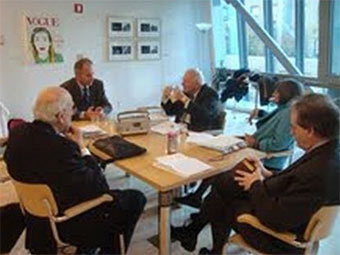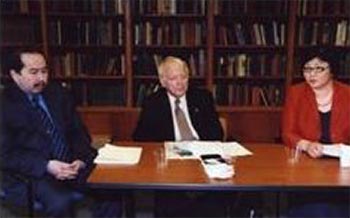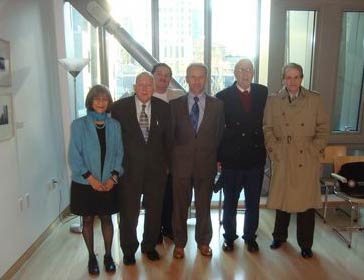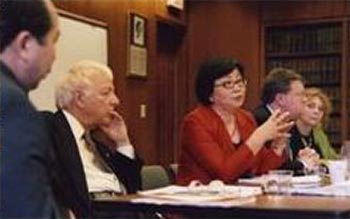Location: Church Center for the United Nations
777 United Nations Plaza
(44th St. & First Avenue—across the street from the United Nations)
12th Floor
New York, NY 10017
Cost: $70 CE Credits: 3.0
Registration: Please click here for further information. Seating is limited. Please register now.
Sponsored by: INTERNATIONAL SCHOOL FOR MENTAL HEALTH PRACTITIONERS. ISMHP is approved by the American Psychological Association to offer continuing education for psychologists. ISMHP maintains responsibility for the program: His Excellency, Ambassador Anthony DeLuca, Ph.D., Dean ISMHP. Under the auspices of Syrian Orthodox Church in America, associated with the Department of Public Information of the United Nations.
Workshop Description:
What are the causes of collective political violence? What events or motivations bring religious and political leaders—and the people they represent—to give over lives and resources to armed conflict? What justifies the sacrifices made in war and terrorism?
In 1994, Dick Cheney appeared on “Meet the Press” and stated that Haiti was “not worth American lives.” Senator Glenn suggested that the case for intervention could not pass the “Dover Test”—the televised return of body bags. In the twenty years since Viet Nam, only about 400 U. S. soldiers had been killed in action. For a time, it seemed that the grand narrative of warfare had lost its appeal.
Then, the events of September 11th, 2001 changed everything. The United States responded—not only to the actions of the terrorists, but to the taunting words of Bin Laden, who addressed Americans declaring:
“Your most disgraceful case was in Somalia. When tens of your soldiers were killed in minor battles and one American pilot was dragged through in the streets of Mogadishu you left the area carrying disappointment, humiliation, defeat and your dead with you. The extent of your impotence and weaknesses became very clear.”
The subsequent American response to Bin Laden’s provocation served to demonstrate—in no uncertain terms—that the United States was not weak; that Americans too possessed ideals and strength of conviction for which they were willing to kill and die. We now find ourselves—again—in the midst of a world of political violence—a world that we seemed to be on the verge of leaving behind.
Were the events of September 11, 2001 responsible for the world-wide struggle in which we now find ourselves? Or is a deeper psychology at work, driving people on all sides of the conflict to seek out “something to kill and die for?”
John Lennon asked people to imagine a world with “nothing to kill or die for.” Post-modernism proposed the “death of grand narratives,” while multiculturalism and globalization articulated the desire to abandon rigid boundaries. Now we seem to have returned to the bipolar, cold-war narrative of a global clash between antagonistic ideologies.
Using case studies from history—as well as contemporary examples—this workshop will explore the dynamics of collective forms of violence such as terrorism and war; the motives that generate killing and dying in the name of religious and national ideals.
Who Should Attend:
Psychologists, Psychoanalysts and Psychiatrists wishing to explore the use of psychological methods and theories to explore the causes and sources of collective forms of political violence.
Learning Objectives: Through presentation and discussion, participants will explore:
- The nature of attachment to “sacred objects” that transforms violence into a form of virtue.
- The human tendency to bifurcate the world into categories of "good" and "evil."
- The need for and symbolic meaning of enemies.
- The relationship between martyrdom and sacrifice.
- Why wars are difficult to end.
About the Presenter:
Richard A. Koenigsberg received his PhD in Social Psychology from the Graduate Faculty of the New School for Social Research in New York City. His highly acclaimed books—Hitler’s Ideology, The Psychoanalysis of Racism, Revolution and Nationalism, Symbiosis and Separation: Towards a Psychology of Culture, and Dying for One’s Country: War as Sacrifice—established a method and theory for the psychological analysis of political ideology.
The Church Center for the United Nations is located across the street from United Nations headquarters. Tours are available at the Visitors’ Lobby of the General Assembly seven days a week from 9am to 5pm.
Orion Anderson |

 Ambassador Jeenbaev, Ambassador DeLuca,
Ambassador Jeenbaev, Ambassador DeLuca,  Dr. DeLuca (2nd from the left) and Dr. Koenigsberg (far right), Austrian Consulate.
Dr. DeLuca (2nd from the left) and Dr. Koenigsberg (far right), Austrian Consulate. Ambassador Jeenbaev, Ambassador
Ambassador Jeenbaev, Ambassador The Church Center for the United Nations,
The Church Center for the United Nations,  Uganda House, where Koenigsberg taught on "War, Violence and Conflict Management."
Uganda House, where Koenigsberg taught on "War, Violence and Conflict Management."